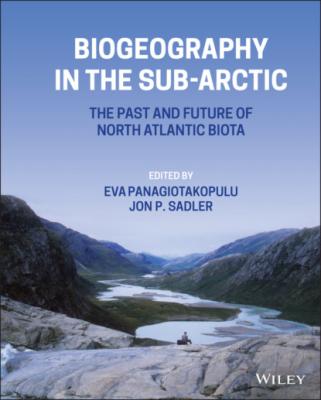Biogeography in the Sub-Arctic. Группа авторов
Читать онлайн.| Название | Biogeography in the Sub-Arctic |
|---|---|
| Автор произведения | Группа авторов |
| Жанр | География |
| Серия | |
| Издательство | География |
| Год выпуска | 0 |
| isbn | 9781118561355 |
Figure 3 (a) Conglomerate from a 2–3 m thick stratum separating Cretaceous shales from the base of the overlying plateau lavas on Wollaston Forland, East Greenland (75° N). Cobbles are of quartzite and muscovite granite. (b) Aerial photograph of the same (white) stratum on Kap Broer Ruys, East Greenland (73°30′N). Well‐stratified dark grey Cretaceous shales beneath and brown/black lavas above.
Source: B.G.J. Upton.
Early in the Eocene mantle temperatures in the head of the plume may have fallen rapidly (Smallwood and White 2002) and the plume is inferred to have assumed a narrower sub‐cylindrical form with a ‘central core’ about a 100 km across. Magmatism due to this ‘plume tail’ marked out the shallow submarine welt of the Greenland–Iceland–Faeroes ridge as the Greenland/American tectonic plate migrated westwards. This ridge is characterized by an abnormal thickness (30–40 km) of oceanic crust and rises to shallow depths. The plume tail itself (the Iceland plume) is now considered to underlie eastern Iceland.
Early Palaeocene Before the North Atlantic Opening
Before the arrival of the postulated mantle plume, the landscapes of Greenland, Norway and Britain largely consisted of relatively high ground composed of early Palaeozoic and Precambrian metamorphic rocks transected by low‐lying faulted basins. The latter, developed during Mesozoic extensional tectonics, were subject to occasional marine inundation. The faulting had structurally preconditioned a tract of the Laurasian continent to a state ripe for exploitation by later rifting and magmatism in the Palaeocene. The embryonic ocean first appeared at approximately 56 Ma around the Palaeocene–Eocene boundary (currently defined at 55.8 ± 0.2 Ma). For the previous 10 Ma we may visualize rifted landscapes roughly comparable to those of Kenya and Ethiopia at present and which appears to have been well vegetated with an equable climate (Walker 1979).
Figure 4 presents a reconstruction of the geography of Greenland, Norway and the British Isles before the ocean opening and shows the pattern of faulting (Jolley and Bell 2002). These ‘normal faults’, generally dipping away from what were to become the Greenland and European hinterlands, presented barriers so that the Mesozoic marine transgressions rarely extended much to the west of the Greenland coastline nor much to the east of the western European coasts. Some of these fault escarpments were rejuvenated to play a role in the Palaeocene–Eocene when they prevented the floods of basaltic lavas from spreading west and east onto what were to become the continental hinterlands.
Figure 5 (see Plate section) shows that the eventual localization of the new ocean approximately followed the axis of the early Palaeozoic Caledonide Orogeny.
Episodes of raised Mesozoic sea‐levels saw the transgression of shallow seas across these low‐lying rifted basins. Whilst there is an abundant environmental and ecological record within the accompanying marine sediments, we can only surmise that during the millions of years between the transgressions there were widespread forested landscapes and little hindrance to intermixing of flora and fauna between North America/Greenland and Eurasia. In the early Palaeocene, before volcanism commenced, shallow non‐marine lakes or swamps formed in these rifts and sedimentary deposits accumulated. Fossil plants in the latter (occasionally forming thin coals) testify to the proximity of vegetated shores. Accordingly, when the first magmas reached surface levels they frequently encountered water or wet sediments and high‐pressure steam generation led to explosive (phreatomagmatic) eruptions. The resultant disrupted particles of basalt magma from these eruptions cooled rapidly to glassy material, the accumulations of which are called hyaloclastites. These are typically accompanied by characteristic sub‐aqueous lava forms, referred to as pillow‐lavas on account of their rounded, tube‐like pillowy forms. As the rates of magma outflow increased and the crust inflated, the waters were expelled and there was evolution from sub‐aqueous to sub‐aerial eruptions. Figure 6 (see Plate section), a coastal section in Baffin Island (East Canada), shows a rift‐related sequence of sediments followed by sub‐aqueous and sub‐aerial volcanic rocks that is broadly similar to the successions generated along the East Greenland coast.
Figure 4 Fault pattern in the North Atlantic region on a map restored to continental dispositions prior to ocean opening.
Source: Jolley and Bell (2002).
Figure 5 Map showing the orogenic belts on either side of the North Atlantic. Note that between Greenland and Norway the North Atlantic is approximately bilaterally symmetrical through the Caledonian Orogenic belt.
Source: Gee et al. 2008.
Figure 6 A coastal section on Cape Searle Island, Baffin Island, Canada, showing a succession similar to that of parts of the East Greenland coast. Palaeocene non‐marine sediments form the basal third, with white sandstones and dark coals and organic‐rich shales. The central part (pale brownish and not well stratified) is of sub‐aqueous volcanic rocks (picritic hyaloclastites and pillow breccias). The upper third consists of subaerially erupted picritic lavas.
Source: B.G.J.Upton
The Geographical Pattern of Break‐Up
The bathymetry of the ocean shows that the continental shelf alongside east Greenland is narrow compared with that on the European side. Spreading started in the south and propagated northwards at a rate of ~1 m/year (Larsen 1988). Initially the line of opening lay close to the present East Greenland coastline, apart from the region between Kangerdlugssuaq and Hold with Hope where it had a large deflection, convex to the east. Thus, the line of parting was divided into three (Figure 7). To the north and south of this easterly deflection spreading has been simple and continuous up to the present. By contrast, in the deflected mid‐section spreading was complex, with repeated shifts in position of the spreading axis. The mid‐section produced the lavas of central East Greenland and, after continental breaking, the lavas of Iceland and the now extinct Ægir Ridge–Jan Mayen spreading axis (Larsen et al. 1989).
Micro‐continent Formation
